
As trapping season looms, backers cite tradition, critics press to ban methods deemed cruel
10/8/2011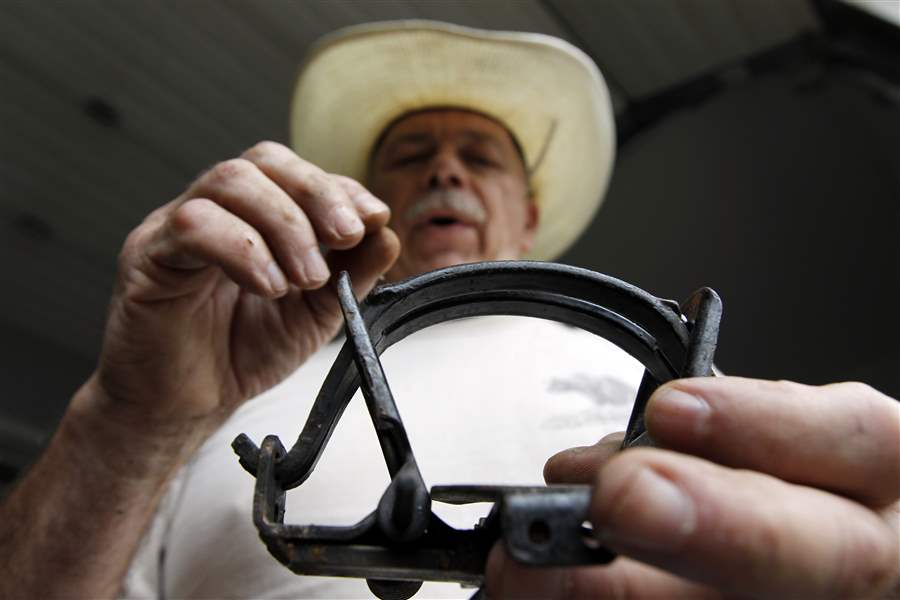
Barry Warner holds a fully modified foot hold trap. "Some people think trappers don't care about wildlife," says Warner. "I don't want to see anything suffer."
ASSOCIATED PRESS
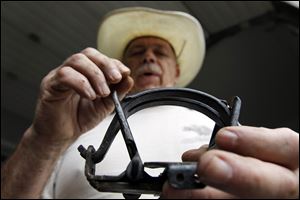
Barry Warner holds a fully modified foot hold trap. "Some people think trappers don't care about wildlife," says Warner. "I don't want to see anything suffer."
COOLBAUGH, Pa. — Barry Warner has loved wildlife since boyhood, and lived out his dream of becoming a conservation officer. He sees no contradiction in the fact that he's also a lifelong trapper, skilled at capturing wild animals and, if appropriate, killing them as part of an avocation that many Americans view as barbarous.
Here in the township of Coolbaugh, on the edge of a vast track of state game land in northeast Pennsylvania, he's in his element. He demonstrates an array of traps unloaded from the back of his truck, reviews his 37-year career with the state game commission, from which he resigned as regional director in 2007, and recounts his periodic forays to North Carolina to trap bobcats, beaver and buck-toothed, wetland-dwelling nutria.
"Some people think trappers don't care about wildlife," says Warner. "It was my love for it that took me into this career. I don't want to see anything suffer."
Over the next few months, tens of thousands of trappers nationwide will fan out through the backcountry. But of all the entrenched outdoor pursuits in America, it's hard to think of any that are more polarizing than the one that unfolds every trapping season.
For proponents, the season is a treasured tradition evoking America's frontier heritage. Trappers consider their quarry a renewable resource and depict themselves as front-line conservationists playing a vital role in wildlife management.
Opponents of trapping see a different picture — pervasive cruelty inflicted on millions of animals each year, largely to help supply domestic and overseas markets for fur.
"Commercial fur trapping dates back to the early 1600s and has hardly changed," says Adam Roberts, executive vice president of Born Free USA. He calls trapping "horrific, highly unregulated, inhumane and dangerous."
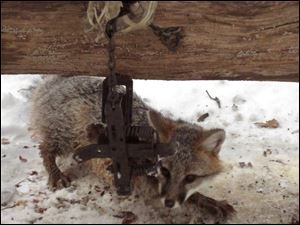
A gray fox is caught in leghold trap in Pennsylvania.
Born Free and other animal-advocacy groups have been campaigning for decades to ban certain types of traps. Earlier this year, Born Free conducted an undercover investigation of trapping in Pennsylvania, and cited its allegations of cruel and abusive practices to petition the game commission for tougher regulations. The petition was unanimously rejected on Oct. 4.
Foes of trapping have scored victories in a few other states, and have caused many trappers to feel under siege, but overall there's been strong support for trapping in both Congress and state legislatures. In at least five states — Louisiana, North Dakota, Oklahoma, Wisconsin, Arkansas — the right to trap has been explicitly enshrined in the state constitution.
"Wildlife management should be left in hands of professionals," says Dave Linkhart, a farmer and trapper from Xenia, Ohio, who is a spokesman for the National Trappers Association.
"Where we've lost some ground," Linkhart adds, "it's in parts of the country where trappers are scarce or not well-organized, and an uninformed or misinformed public gets on the animal-rights bandwagon."
There are about 150,000 trappers in the U.S., according to the Association of Fish and Wildlife Agencies. Most make little profit — perhaps a few hundred dollars per season — selling pelts at prices which range from close to $600 for a bobcat to roughly $15 for a beaver.
"The average guy is doing it because he loves it," says Warner. "If he's lucky, he pays his expenses."
Warner has lived in northeast Pennsylvania his whole life, except for a four-year Air Force stint that included construction work in Vietnam. After the service, he worked as a carpenter before getting hired by the game commission.
A genial bachelor, still fit at 66, Warner views trapping as a cause rather than a diversion. For decades, he's been deeply involved in training wildlife officers and would-be trappers about trapping techniques and ethics issues such as minimizing distress to animals and avoiding non-target species.
To him, the animals are "critters." He favors a Stetson-style hat and jeans, and his favorite films include "Jeremiah Johnson," in which Robert Redford plays a mountain man who supports himself by trapping.
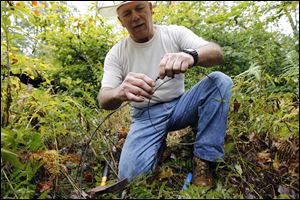
Barry Warner demonstrates setting a cable restraint trap in Coolbaugh, Pa.
Non-trappers tend to underestimate the skill and hard work involved in trapping, says Warner, who considers it more challenging, on average, than hunting.
"Hunters can get lucky. It's a lot more complicated with traps," he says. "If you don't know what you're doing — how to set them properly, where to set them — you're not going to be successful."
There are numerous types of traps, used for different purposes and animals, ranging from box traps which catch animals alive to snare traps which employ a noose of cable or wire. A newer version of snares called cable restraints are designed to catch foxes and coyotes without killing them.
Among the emphatically deadly varieties are Conibear traps — designed to suffocate an animal by crushing its neck or spinal column. They're used most often to trap muskrats and beavers.
The most common type of trap, used to catch an array of animals, is the subject of a semantic battle — it's called the leghold trap by many of its critics and the foothold trap by many of its defenders. Past versions of these traps often had metal teeth on the jaws; now it's common for the jaws to be laminated or padded.
Animal-advocacy groups contend that animals captured in these traps feel so much pain that they sometimes chew off their own paw in frantic efforts to escape. Trappers deny this is a common occurrence and say current versions of the traps don't cause severe pain.
The European Union and many other countries have banned leghold traps, as have seven U.S. states, but there have been some complications. In Massachusetts, the beaver population exploded after a ban was imposed by voters in 1996; in California, experts reported a rise in coyote attacks on humans after its leghold ban was approved in 1998.
Seeking to cut down on abuses by trappers, the Association of Fish and Wildlife Agencies has been working for the past 15 years on what it calls Best Management Practices — guidelines for how to use various types of traps, deal properly with captured fur-bearers and avoid catching non-targeted animals.
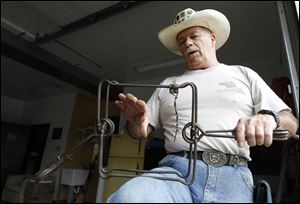
Barry Warner holds a beaver body gripping trap.
Many of the state wildlife agencies represented by the association have incorporated these guidelines into their own education programs, which are sometimes required in order to obtain certain trapping licenses. State trapper organizations, including Pennsylvania's, also offer adult and youth education programs, in part to counter anti-trapping activists.
"We know we're in their sights," said Brian Mohn, president of the Pennsylvania Trappers Association.
In March, Born Free USA released the results of an undercover investigation of wildlife trapping that it conducted in Pennsylvania.
The organization said its video and photos revealed "shocking cruelty and brutality" — including the prolonged drowning of a raccoon by a trapper with a stick, and the killing of two foxes after they were caught in what Born Free said was an illegal snare trap.
Trappers belittled some of the footage, but Mohn acknowledged being troubled by the raccoon drowning sequence.
"We don't condone something like that," he said. "We recommend a shot in the head, to dispatch the animal quickly and humanely."
The investigation attracted relatively little news coverage — Adam Roberts suggested the video footage may have been deemed too gruesome. Born Free used the findings to support its unsuccessful petition to the Pennsylvania Game Commission for tougher trapping regulations.
Among the proposals rejected by the commission were a ban on cable restraint traps, a requirement that traps be checked every 24 hours instead of the current 36-hour time frame, and mandatory reporting of the number and type of non-target animals caught by traps.
Born Free contends that one-third of trapped animals are not the trappers' intended target — and cites instances where pet dogs and cats are ensnared and sometimes killed. Trappers acknowledge that pets sometimes are caught, but rarely.
"Most trappers have dogs and cats of their own," said Mohn.
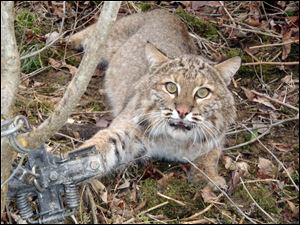
A bobcat is caught in a leghold trap in New Mexico.
Mohn, 52, started trapping as a 6th grader in Hamburg, Pa.; sold fur to help pay his college tuition, and taught his three daughters so well that they all won the state's Youth Trapper of the Year award.
He says membership in the state association is down to about 4,000 from a peak of 10,000 in the 1980s. Yet the state issued more than 35,000 trapping licenses last year, up from 18,551 in 2000, suggesting it is not a fading pastime. The latest annual state figures report a harvest of more about 112,000 raccoons, 64,000 muskrats, 50,000 foxes and 30,000 coyotes.
Mohn, a farm manager, says he and his colleagues devote a lot of energy to building alliances with other outdoor sportspeople — and to public relations.
"We have to watch the message we're conveying to the general public," he said. "You can have 25,000 trappers doing everything correct, and one case where something's wrong and that becomes the poster child."
Beyond Pennsylvania, trapping has been a hot issue recently in New Mexico, where there's vigorous debate over whether the state should prohibit the trapping of bobcats, raccoons and other fur-bearing animals on public lands. Several conservation groups have urged such a ban; trappers accuse them of scare tactics and disinformation.
"If trapping was doing evil, that would be one thing. It's not. It's balancing things," said Tom McDowell of the New Mexico Trappers Association. "They have painted us as cruel and barbaric. It's terribly unfair, and it's just not true."
In Congress, Rep. Nita Lowey, D-N.Y., introduced a bill in July that would ban the use of body-gripping traps within federal wildlife refuges. The ban would encompass leghold, snare and Conibear traps; cage and box traps would still be allowed.
"The use of steel jaw leghold traps and other barbaric mechanisms has no place in National Wildlife Refuges," said Lowey. "It is time to end this brutal practice once and for all."
More than half of the nation's refuge lands currently allow the use of body-gripping traps.
Born Free's Roberts is hopeful that Lowey's bill can gain bipartisan support, but the trappers have powerful allies in Congress, including Rep. Don Young, R-Alaska, who was a commercial trapper in 1960s.
Moreover, the U.S. Fish and Wildlife Service is on record as defending trapping in the wildlife refuges — whether for resource management and disease control, or for economic and recreational purposes.
While Born Free conducts campaigns to promote anti-trapping legislation, some other animal-advocacy groups — such as the Humane Society of the United States and People for the Ethical Treatment of Animals — focus on trying to weaken the fur industry.
"We show the garment makers the traps, tell them the way animals suffer and die in them is just not OK," said Andrew Page, senior director of wildlife and fur campaigns for the HSUS.
Of all the fur produced annually in the U.S., most comes from fur farms, which animal-advocacy groups also consider to be cruel. PETA estimates that about 15 percent of U.S. fur supplies come from trappers and says the best way to combat trapping is to persuade consumers not to wear fur.
"Most people assume that kind of cruelty could not possibly be legal," said PETA's Ashley Byrne. "If they did realize how excruciating it is to be caught in one of these traps, they'd be absolutely shocked."
___
ONLINE:
Born Free USA: http://www.bornfreeusa.org/a10a_victims.php
National Trappers Association: http://www.nationaltrappers.com/
Pennsylvania Trappers Association: http://www.patrappers.com/
U.S. Fish and Wildlife Service: http://www.fws.gov/refuges/hunting/trapping.html
Best Management Practices: http://www.fishwildlife.org/files/Introduction_BMPs.pdf